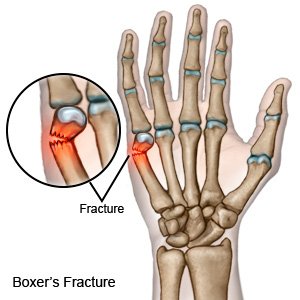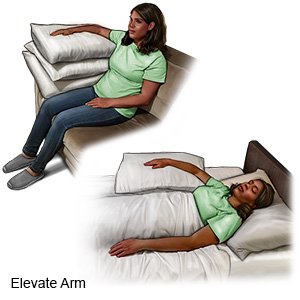Boxer Fracture
Medically reviewed by Drugs.com. Last updated on Aug 4, 2025.
A boxer fracture is a break of a bone in your hand. It usually happens in the bone that connects your wrist to your little finger or ring finger.
 |
DISCHARGE INSTRUCTIONS:
Return to the emergency department if:
- You cannot bend or extend your finger.
- You have severe pain.
- You have numbness or tingling in your finger.
Call your doctor if:
- You have a fever.
- Your open wound is red, swollen, or draining pus.
- You have trouble moving your finger.
- You have questions or concerns about your condition or care.
Medicines:
You may need any of the following:
- NSAIDs , such as ibuprofen, help decrease swelling, pain, and fever. This medicine is available with or without a doctor's order. NSAIDs can cause stomach bleeding or kidney problems in certain people. If you take blood thinner medicine, always ask your healthcare provider if NSAIDs are safe for you. Always read the medicine label and follow directions.
- Prescription pain medicine may be given. Ask your healthcare provider how to take this medicine safely. Some prescription pain medicines contain acetaminophen. Do not take other medicines that contain acetaminophen without talking to your healthcare provider. Too much acetaminophen may cause liver damage. Prescription pain medicine may cause constipation. Ask your healthcare provider how to prevent or treat constipation.
- Take your medicine as directed. Contact your healthcare provider if you think your medicine is not helping or if you have side effects. Tell your provider if you are allergic to any medicine. Keep a list of the medicines, vitamins, and herbs you take. Include the amounts, and when and why you take them. Bring the list or the pill bottles to follow-up visits. Carry your medicine list with you in case of an emergency.
Self-care:
- Apply ice on your injury for 15 to 20 minutes every hour for 24 hours or as directed. Use an ice pack, or put crushed ice in a plastic bag. Cover it with a towel. Ice helps prevent tissue damage and decreases swelling and pain.
- Elevate your hand above the level of your heart as often as you can. This will help decrease swelling and pain. Prop your hand on pillows or blankets to keep it elevated comfortably.

- Go to physical therapy if directed. A physical therapist teaches you exercises to help improve movement and strength, and to decrease pain.
Follow up with your doctor or orthopedist as directed:
You may need to return for more x-rays or another cast. Write down your questions so you remember to ask them during your visits.
© Copyright Merative 2025 Information is for End User's use only and may not be sold, redistributed or otherwise used for commercial purposes.
The above information is an educational aid only. It is not intended as medical advice for individual conditions or treatments. Talk to your doctor, nurse or pharmacist before following any medical regimen to see if it is safe and effective for you.
Further information
Always consult your healthcare provider to ensure the information displayed on this page applies to your personal circumstances.
